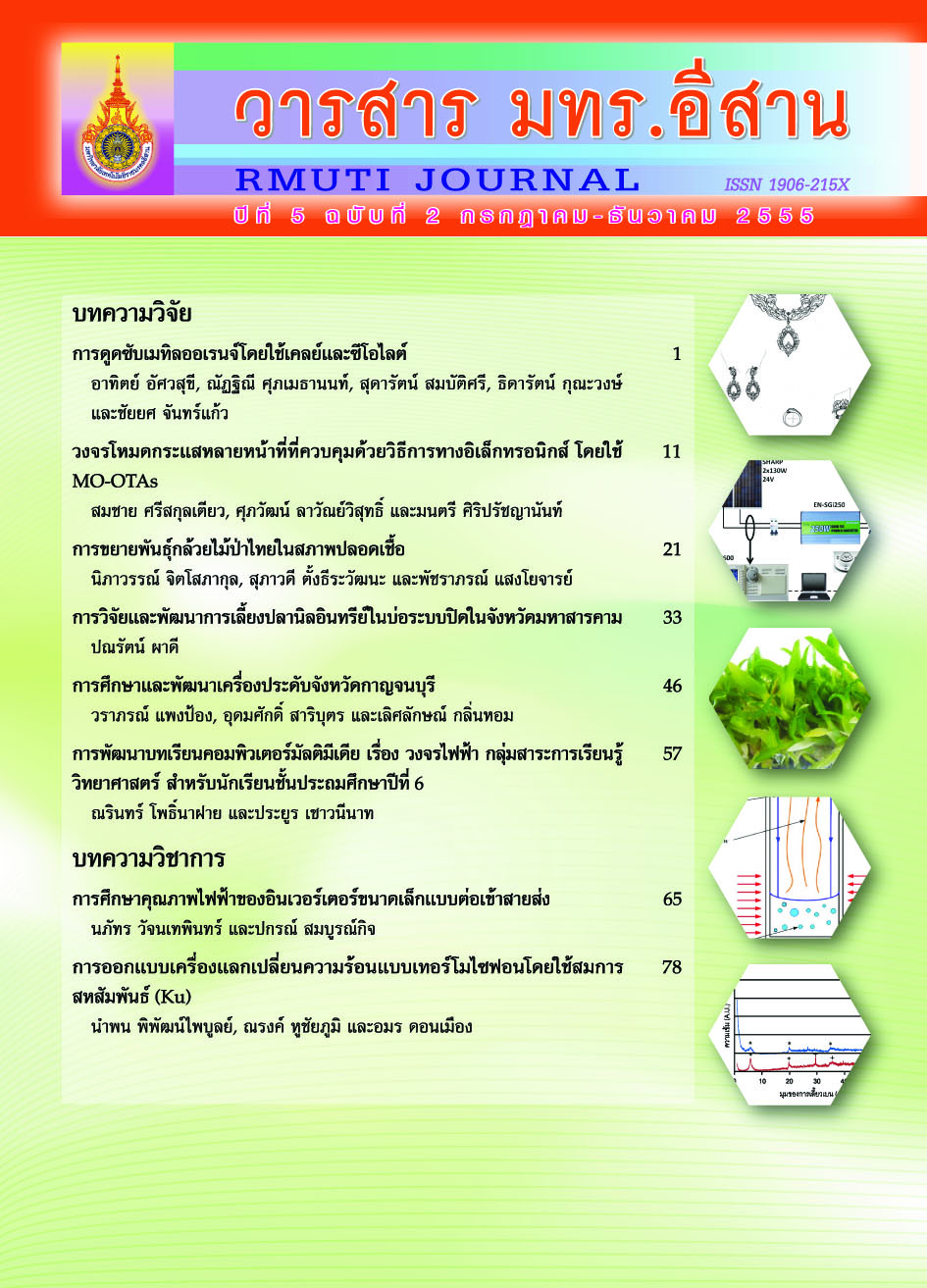การพัฒนาบทเรียนคอมพิวเตอร์มัลติมีเดีย เรื่อง วงจรไฟฟ้า กลุ่มสาระการเรียนรู้วิทยาศาสตร์ สำหรับนักเรียนชั้นประถมศึกษาปีที่ 6
Main Article Content
Abstract
บทคัดย่อ
การวิจัยครั้งนี้มีวัตฤประสงค์ เพื่อ 1) พัฒนาบทเรียนคอมพิวเตอร์มัลติมีเดีย เรื่อวงจรไฟฟ้ากลุ่มสาระ การเรียนรู้วิทยาศาสตร์ สำหรับนักเรียนชั้นประถมศึกษาปีที6 ให้มีประสิทธิภาพตามเกณฑ์ 80/80 2) เพื่อเปรียบเทียบผลสมฤทธิ๋ทางการเรียนกับคะแนนสอบก่อนเรียนด้วยบทเรียนคอมพิวเตอร์มัลติมิเดีย เรื่อง วงจรไฟฟ้ากลุ่มสาระการเรียนรู้วิทยาศาสตร์ สำหรับนักเรียนชั้นประถมศึกษาปีที่ 6 และ 3) เพื่อศึกษาความพึงพอใจของนักเรียนชั้นประถมศึกษาปีที่ 6 ที่มีต่อบทเรียนคอมพิวเตอร์มัลติมีเดีย เรื่อง วงจรไฟฟ้ากลุ่มสาระการเรียนรู้วิทยาศาสตร์ กลุ่มตัวอย่างในการวิจัย คือ นักเรียนชั้นประถมศึกษาปีที่ 6 ในภาคเรียนที่ 1 ปีการศึกษา 2554 ในศูนย์พัฒนาคุณภาพมาตรฐานการศึกษาห้วยต้อนนาฝาย อำเภอเมือง จังหวัดชัยภูมิ จำนวน 35 คน ทืได้จากการวิธีการสุ่มตัวอย่างแบบง่าย เครื่องมือที่ใช้ ในการเก็บรวบรวมข้อมูล ได้แก่ แผนการจัดการเรียนรู้ บทเรียนคอมพิวเตอร์มัลติมืเดีย เรื่อง วงจรไฟฟ้า กลุ่มสาระการเรียนรู้วิทยาศาสตร์ แบบทดสอบวัดผลสมฤทธิ้ทางการเรียน และแบบสอบถามความพิงพอใจ ของนักเรียนที่มืต่อบทเรียนคอมพิวเตอร์มัลติมิเดีย สถิติที่ใช้ในการวิเคราะห์ข้อมูล คือ ค่าร้อยละ ค่าเฉลี่ย ส่วนเบี่ยงเบนมาตรฐาน และทดสอบสมมุติฐาน โดยใช้การทดสอบค่าที (t-test -dependent sample)
ผลการวิจัยพบว่า
บทเรียนคอมพิวเตอร์มัลติมิเดีย เรื่อง วงจรไฟฟ้ากลุ่มสาระการเรียนรู้วิทยาศาสตร์ สำหรับ นักเรียนชั้นประถมศึกษาปีที 6 มิประสิทธีภาพ 81.15/81.42 โดยมิค่าตามเกณฑ์ประสิทธีภาพที่ตั้งไว้ เท่ากับ 80/80 เมื่อเปรียบเทียบผลสมฤทธิ๋ทางการเรียนโดยใช้บทเรียนคอมพิวเตอร์มัลติมีเดีย เรื่อง วงจรไฟฟ้าของนักเรียนชั้นประถมศึกษาปีที่ 6 พบว่า สูงกว่าคะแนนทดสอบก่อนเรียนอย่างมีนัยสำคัญ ทางสถิติที่ระดับ 0.01 และนักเรียนชั้นประถมศึกษาปีที่ 6 มีความพึงพอใจต่อการเรียนด้วยบทเรียน คอมพิวเตอร์มัลติมีเดียเรื่องวงจรไฟฟ้า กลุ่มสาระการเรียนรู้วิทยาศาสตร์ มีค่าเฉลี่ยโดยภาพรวม อยู่ใน ระดับมากที่สุด โดยมีค่าเฉลี่ยเท่ากับ (X = 4.57, S.D. = 0.58)
คำสำคัญ : การพัฒนา, บทเรียนคอมพิวเตอร์มัลติมีเดีย
Abstract
This research aimed to: 1) develop the multi-media computerized lessons, entitled Electrical Circuits, Science Learning Strand for Prathomsuksa 6 students to achieve the efficiency criterion 80/80, 2) compare the learning achievements to the pre-test scores by studying with the multi-media computerized lessons, entitled Electrical Circuits, Science Learning Strand for Prathomsuksa 6 students, and 3) study the satisfactions towards the multi-media computerized lessons, entitled Electrical Circuits, Science Learning Strand for Prathomsuksa. The samples of the research were 35 Prathomsuksa 6 students studying in Huayton-Nafai Education Standard - Quality Development Center, Muang Chaiyaphum District, Chaiyaphum Province., derived by the simple random sampling. The instruments for collecting the data included the lesson plans, multi-media computerized lessons, learning achievement test and satisfaction questionnaires on the multi-media computerized lessons. The statistics used for analyzing the data were the percentage, mean, standard deviation, the hypothesis testing by the t-test of dependent samples.
The research findings revealed that :
The multi-media computerized lessons, entitled Electrical Circuits, Science Learning Strand for Prathomsuksa 6 Students achieved the efficiency criterion equaled 81.51/81.42 achieving the 80/80 efficiency criterion. When comparing the learning achievements by using the multi-media computerized lessons, entitled Electrical Circuits, Science Learning Strand for Prathomsuksa 6 Students, they appeared higher than the pre-test scores significantly at the 0.01 statistically significant level, and Prathomsuksa 6 students had the satisfactions on using the multi-media computerized lessons, entitled Electrical Circuits, Science Learning Strand, having the whole mean scores in the most level of (X = 4.57, S.D. = 0.58)
Keyword : Development, Multi-media Computerized Lessons


